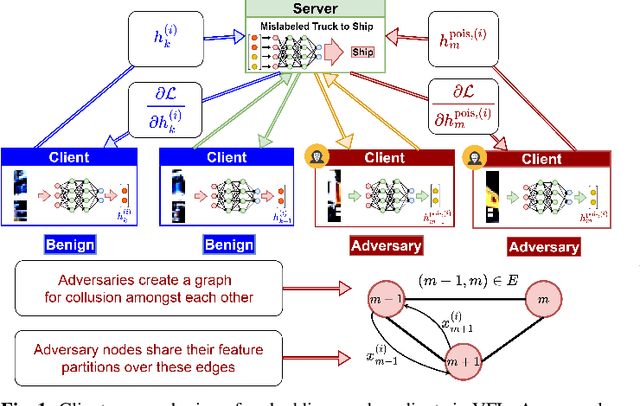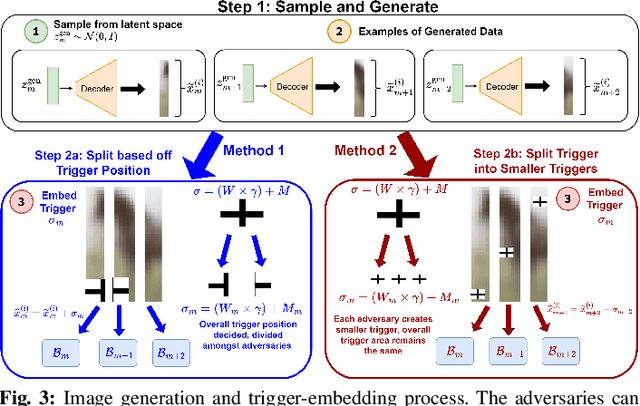Anindya Bijoy Das
Trustworthy Medical Imaging with Large Language Models: A Study of Hallucinations Across Modalities
Aug 09, 2025Abstract:Large Language Models (LLMs) are increasingly applied to medical imaging tasks, including image interpretation and synthetic image generation. However, these models often produce hallucinations, which are confident but incorrect outputs that can mislead clinical decisions. This study examines hallucinations in two directions: image to text, where LLMs generate reports from X-ray, CT, or MRI scans, and text to image, where models create medical images from clinical prompts. We analyze errors such as factual inconsistencies and anatomical inaccuracies, evaluating outputs using expert informed criteria across imaging modalities. Our findings reveal common patterns of hallucination in both interpretive and generative tasks, with implications for clinical reliability. We also discuss factors contributing to these failures, including model architecture and training data. By systematically studying both image understanding and generation, this work provides insights into improving the safety and trustworthiness of LLM driven medical imaging systems.
Can Large Language Models Challenge CNNS in Medical Image Analysis?
May 29, 2025Abstract:This study presents a multimodal AI framework designed for precisely classifying medical diagnostic images. Utilizing publicly available datasets, the proposed system compares the strengths of convolutional neural networks (CNNs) and different large language models (LLMs). This in-depth comparative analysis highlights key differences in diagnostic performance, execution efficiency, and environmental impacts. Model evaluation was based on accuracy, F1-score, average execution time, average energy consumption, and estimated $CO_2$ emission. The findings indicate that although CNN-based models can outperform various multimodal techniques that incorporate both images and contextual information, applying additional filtering on top of LLMs can lead to substantial performance gains. These findings highlight the transformative potential of multimodal AI systems to enhance the reliability, efficiency, and scalability of medical diagnostics in clinical settings.
Hallucinations and Key Information Extraction in Medical Texts: A Comprehensive Assessment of Open-Source Large Language Models
Apr 27, 2025Abstract:Clinical summarization is crucial in healthcare as it distills complex medical data into digestible information, enhancing patient understanding and care management. Large language models (LLMs) have shown significant potential in automating and improving the accuracy of such summarizations due to their advanced natural language understanding capabilities. These models are particularly applicable in the context of summarizing medical/clinical texts, where precise and concise information transfer is essential. In this paper, we investigate the effectiveness of open-source LLMs in extracting key events from discharge reports, such as reasons for hospital admission, significant in-hospital events, and critical follow-up actions. In addition, we also assess the prevalence of various types of hallucinations in the summaries produced by these models. Detecting hallucinations is vital as it directly influences the reliability of the information, potentially affecting patient care and treatment outcomes. We conduct comprehensive numerical simulations to rigorously evaluate the performance of these models, further probing the accuracy and fidelity of the extracted content in clinical summarization.
Learning-Based Two-Way Communications: Algorithmic Framework and Comparative Analysis
Apr 22, 2025



Abstract:Machine learning (ML)-based feedback channel coding has garnered significant research interest in the past few years. However, there has been limited research exploring ML approaches in the so-called "two-way" setting where two users jointly encode messages and feedback for each other over a shared channel. In this work, we present a general architecture for ML-based two-way feedback coding, and show how several popular one-way schemes can be converted to the two-way setting through our framework. We compare such schemes against their one-way counterparts, revealing error-rate benefits of ML-based two-way coding in certain signal-to-noise ratio (SNR) regimes. We then analyze the tradeoffs between error performance and computational overhead for three state-of-the-art neural network coding models instantiated in the two-way paradigm.
Multi-Agent Reinforcement Learning for Graph Discovery in D2D-Enabled Federated Learning
Mar 29, 2025Abstract:Augmenting federated learning (FL) with device-to-device (D2D) communications can help improve convergence speed and reduce model bias through local information exchange. However, data privacy concerns, trust constraints between devices, and unreliable wireless channels each pose challenges in finding an effective yet resource efficient D2D graph structure. In this paper, we develop a decentralized reinforcement learning (RL) method for D2D graph discovery that promotes communication of impactful datapoints over reliable links for multiple learning paradigms, while following both data and device-specific trust constraints. An independent RL agent at each device trains a policy to predict the impact of incoming links in a decentralized manner without exposure of local data or significant communication overhead. For supervised settings, the D2D graph aims to improve device-specific label diversity without compromising system-level performance. For semi-supervised settings, we enable this by incorporating distributed label propagation. For unsupervised settings, we develop a variation-based diversity metric which estimates data diversity in terms of occupied latent space. Numerical experiments on five widely used datasets confirm that the data diversity improvements induced by our method increase convergence speed by up to 3 times while reducing energy consumption by up to 5 times. They also show that our method is resilient to stragglers and changes in the aggregation interval. Finally, we show that our method offers scalability benefits for larger system sizes without increases in relative overhead, and adaptability to various downstream FL architectures and to dynamic wireless environments.
Cooperative Decentralized Backdoor Attacks on Vertical Federated Learning
Jan 16, 2025



Abstract:Federated learning (FL) is vulnerable to backdoor attacks, where adversaries alter model behavior on target classification labels by embedding triggers into data samples. While these attacks have received considerable attention in horizontal FL, they are less understood for vertical FL (VFL), where devices hold different features of the samples, and only the server holds the labels. In this work, we propose a novel backdoor attack on VFL which (i) does not rely on gradient information from the server and (ii) considers potential collusion among multiple adversaries for sample selection and trigger embedding. Our label inference model augments variational autoencoders with metric learning, which adversaries can train locally. A consensus process over the adversary graph topology determines which datapoints to poison. We further propose methods for trigger splitting across the adversaries, with an intensity-based implantation scheme skewing the server towards the trigger. Our convergence analysis reveals the impact of backdoor perturbations on VFL indicated by a stationarity gap for the trained model, which we verify empirically as well. We conduct experiments comparing our attack with recent backdoor VFL approaches, finding that ours obtains significantly higher success rates for the same main task performance despite not using server information. Additionally, our results verify the impact of collusion on attack performance.
Challenging Fairness: A Comprehensive Exploration of Bias in LLM-Based Recommendations
Sep 17, 2024Abstract:Large Language Model (LLM)-based recommendation systems provide more comprehensive recommendations than traditional systems by deeply analyzing content and user behavior. However, these systems often exhibit biases, favoring mainstream content while marginalizing non-traditional options due to skewed training data. This study investigates the intricate relationship between bias and LLM-based recommendation systems, with a focus on music, song, and book recommendations across diverse demographic and cultural groups. Through a comprehensive analysis conducted over different LLM-models, this paper evaluates the impact of bias on recommendation outcomes. Our findings reveal that bias is so deeply ingrained within these systems that even a simpler intervention like prompt engineering can significantly reduce bias, underscoring the pervasive nature of the issue. Moreover, factors like intersecting identities and contextual information, such as socioeconomic status, further amplify these biases, demonstrating the complexity and depth of the challenges faced in creating fair recommendations across different groups.
Constant Modulus Waveform Design with Interference Exploitation for DFRC Systems: A Block-Level Optimization Approach
Jun 27, 2024



Abstract:Dual-function radar-communication (DFRC) is a key enabler of location-based services for next-generation communication systems. In this paper, we investigate the problem of designing constant modulus waveforms for DFRC systems. For high-precision radar sensing, we consider joint optimization of the correlation properties and spatial beam pattern. For communication, we employ constructive interference-based block-level precoding (CI-BLP) to leverage distortion induced by multiuser multiple-input multiple-output (MU-MIMO) and radar transmission on a block level. We propose two solution algorithms based on the alternating direction method of multipliers (ADMM) and majorization-minimization (MM) principles, which are effective for small and large block sizes, respectively. The proposed ADMM-based solution decomposes the nonconvex formulated problem into multiple tractable subproblems, each of which admits a closed-form solution. To accelerate convergence of the MM-based solution, we propose an improved majorizing function that leverages a novel diagonal matrix structure. After majorization, we decompose the approximated problem into independent subproblems for parallelization, mitigating the complexity that increases with block size. We then evaluate the performance of the proposed algorithms through a series of numerical experiments. Simulation results demonstrate that the proposed methods can substantially enhance spatial/temporal sidelobe suppression through block-level optimization.
Multi-Agent Hybrid SAC for Joint SS-DSA in CRNs
Apr 22, 2024Abstract:Opportunistic spectrum access has the potential to increase the efficiency of spectrum utilization in cognitive radio networks (CRNs). In CRNs, both spectrum sensing and resource allocation (SSRA) are critical to maximizing system throughput while minimizing collisions of secondary users with the primary network. However, many works in dynamic spectrum access do not consider the impact of imperfect sensing information such as mis-detected channels, which the additional information available in joint SSRA can help remediate. In this work, we examine joint SSRA as an optimization which seeks to maximize a CRN's net communication rate subject to constraints on channel sensing, channel access, and transmit power. Given the non-trivial nature of the problem, we leverage multi-agent reinforcement learning to enable a network of secondary users to dynamically access unoccupied spectrum via only local test statistics, formulated under the energy detection paradigm of spectrum sensing. In doing so, we develop a novel multi-agent implementation of hybrid soft actor critic, MHSAC, based on the QMIX mixing scheme. Through experiments, we find that our SSRA algorithm, HySSRA, is successful in maximizing the CRN's utilization of spectrum resources while also limiting its interference with the primary network, and outperforms the current state-of-the-art by a wide margin. We also explore the impact of wireless variations such as coherence time on the efficacy of the system.
Minimum Description Feature Selection for Complexity Reduction in Machine Learning-based Wireless Positioning
Apr 21, 2024



Abstract:Recently, deep learning approaches have provided solutions to difficult problems in wireless positioning (WP). Although these WP algorithms have attained excellent and consistent performance against complex channel environments, the computational complexity coming from processing high-dimensional features can be prohibitive for mobile applications. In this work, we design a novel positioning neural network (P-NN) that utilizes the minimum description features to substantially reduce the complexity of deep learning-based WP. P-NN's feature selection strategy is based on maximum power measurements and their temporal locations to convey information needed to conduct WP. We improve P-NN's learning ability by intelligently processing two different types of inputs: sparse image and measurement matrices. Specifically, we implement a self-attention layer to reinforce the training ability of our network. We also develop a technique to adapt feature space size, optimizing over the expected information gain and the classification capability quantified with information-theoretic measures on signal bin selection. Numerical results show that P-NN achieves a significant advantage in performance-complexity tradeoff over deep learning baselines that leverage the full power delay profile (PDP). In particular, we find that P-NN achieves a large improvement in performance for low SNR, as unnecessary measurements are discarded in our minimum description features.
 Add to Chrome
Add to Chrome Add to Firefox
Add to Firefox Add to Edge
Add to Edge